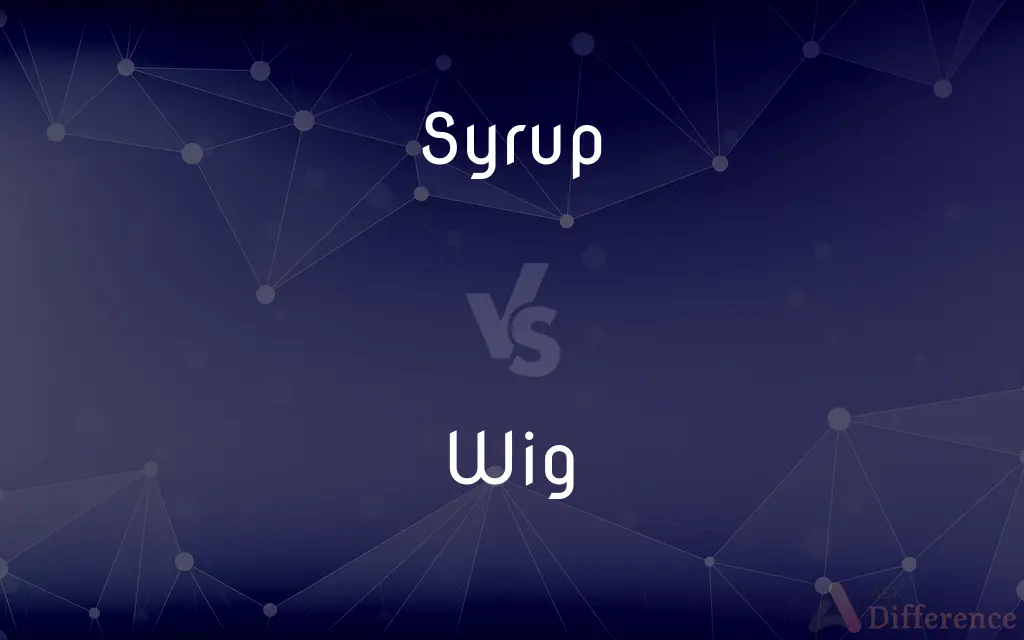Syrup vs. Wig — What's the Difference?
By Tayyaba Rehman — Updated on October 27, 2023
Syrup is a thick, sweet liquid, while a wig is a head covering made from real or synthetic hair.

Difference Between Syrup and Wig
Table of Contents
ADVERTISEMENT
Key Differences
Syrup, often derived from plants like sugar cane or maple trees, is a viscous liquid sweetener used in culinary applications. In contrast, a wig is a hairpiece crafted from natural or artificial hair, designed to conceal hair loss or for fashion purposes. Both items, though starkly different, reflect human ingenuity in their respective fields: culinary arts and personal grooming.
The origins of syrup trace back to ancient culinary practices, used for sweetening and preserving food. Wigs, meanwhile, have a rich history in fashion and cultural practices, dating back to ancient civilizations like Egypt. While syrup enhances flavor, wigs transform appearances, both serving distinct human desires: taste and aesthetics.
In terms of production, syrup is created through processes like boiling and refining natural sugars. Wig making, on the other hand, involves meticulous crafting, styling, and sometimes dyeing hair. Both processes require skill, but syrup production is more industrial, whereas wig making can range from industrial to highly personalized craftsmanship.
Syrup’s usage is predominantly in the culinary world, as a sweetener in dishes, beverages, or medicines. Wigs serve a different purpose, used for cosmetic, cultural, or medical reasons, like covering hair loss. Though unrelated in function, both can bring comfort, syrup through its sweetness and wigs through enhancing one’s appearance.
In contemporary society, syrup continues to be a staple in kitchens worldwide, while wigs have evolved into fashion statements and practical solutions for hair loss. Despite their unrelated nature, both syrup and wigs have maintained their relevance and importance in modern life.
ADVERTISEMENT
Comparison Chart
Primary Material
Derived from natural sources like sugar cane.
Made from real or synthetic hair.
Primary Use
Used as a sweetener in food and drinks.
Used to cover the head for aesthetic or medical purposes.
Historical Origin
Ancient culinary practices.
Ancient cultural and fashion practices.
Production Process
Involves boiling and refining.
Involves crafting and styling hair.
Cultural Significance
Common in culinary traditions.
Varied significance in fashion and personal identity.
Compare with Definitions
Syrup
A concentrated solution of sugar in water.
The homemade lemonade was sweetened with a simple syrup.
Wig
A hairpiece used for theatrical or cosmetic purposes.
The actor donned a wig to portray the historical character.
Syrup
A syrupy consistency or nature.
The syrup-like texture of the sauce added richness to the dish.
Wig
A decorative or fashionable hair accessory.
For the costume party, she chose a colorful wig.
Syrup
A sugary solution used in beverages or cocktails.
He added grenadine syrup to the mocktail for flavor.
Wig
A head covering made from real or synthetic hair.
She wore a wig to change her hairstyle for the event.
Syrup
A medicinal preparation used as a laxative or cough suppressant.
She took a spoonful of cough syrup before bedtime.
Wig
A covering worn for disguise or to conceal baldness.
He chose a wig to cover his hair loss with confidence.
Syrup
In cooking, a syrup or sirup (from Arabic: شراب; sharāb, beverage, wine and Latin: sirupus) is a condiment that is a thick, viscous liquid consisting primarily of a solution of sugar in water, containing a large amount of dissolved sugars but showing little tendency to deposit crystals. Its consistency is similar to that of molasses.
Wig
An artificial head of hair, often signifying a role or status.
In the courtroom, the judge wore a traditional wig.
Syrup
A thick, sweet liquid made by dissolving sugar in boiling water, often used for preserving fruit.
Wig
A wig is a head or hair accessory made from human hair, animal hair, or synthetic fiber. The word wig is short for periwig, which makes its earliest known appearance in the English language in William Shakespeare's The Two Gentlemen of Verona.
Syrup
A wig
He has been bald for the past twenty years, his shame concealed by a syrup of some opulence
Wig
An artificial covering of natural or synthetic hair worn on the head for personal adornment, as part of a costume, or to conceal baldness.
Syrup
A thick, sweet, sticky liquid, consisting of a sugar base, natural or artificial flavorings, and water.
Wig
To scold or censure.
Syrup
A thick, sugary liquid made by boiling down or otherwise concentrating plant sap, juice, or grain extracts.
Wig
A head of real or synthetic hair worn on the head to disguise baldness, for cultural or religious reasons, for fashion, or by actors to help them better resemble the character they are portraying.
Syrup
A concentrated solution of sugar in water, often used as a vehicle for medicine.
Wig
A bigwig
Syrup
Any thick liquid that has a high sugar content and which is added to or poured over food as a flavouring.
Maple syrup
Pancake syrup
Peaches in syrup
Wig
An old seal.
Syrup
(by extension) Any viscous liquid.
Cough syrup
Wig
To put on a wig; to provide with a wig (especially of an actor etc.).
Syrup
A wig.
Wig
To upbraid, reprimand.
Syrup
(transitive) To convert or process into syrup.
Wig
To act in an extremely emotional way; to be overly excited, irritable, nervous, or fearful; behave erratically.
That guy must be high. Look how he's wigging.
Syrup
(transitive) To add syrup to.
Wig
A covering for the head, consisting of hair interwoven or united by a kind of network, either in imitation of the natural growth, or in abundant and flowing curls, worn to supply a deficiency of natural hair, or for ornament, or according to traditional usage, as a part of an official or professional dress, the latter especially in England by judges and barristers.
Syrup
(transitive) To sabotage (a vehicle) by pouring syrup into the gas tank.
Wig
An old seal; - so called by fishermen.
Syrup
Same as Sirup, Sirupy.
Wig
To censure or rebuke; to hold up to reprobation; to scold.
Syrup
A thick sweet sticky liquid
Wig
Hairpiece covering the head and made of real or synthetic hair
Syrup
A thick, sweet liquid made from sugar.
The pancakes were topped with maple syrup.
Wig
British slang for a scolding
Common Curiosities
Are all syrups sweet?
Most syrups are sweet, but some may have added flavors or medicinal ingredients.
What is syrup made of?
Syrup is typically made from sugar dissolved in water or extracted from plants like sugar cane or maple trees.
Can syrup be used in savory dishes?
Yes, syrup can be used to sweeten or glaze savory dishes.
Can syrup go bad?
Syrup can spoil if contaminated, but it generally has a long shelf life.
What are wigs made from?
Wigs can be made from real human hair, animal hair, or synthetic fibers.
Do wigs look natural?
High-quality wigs, especially those made from real hair, can look very natural.
Is maple syrup the same as pancake syrup?
No, maple syrup is made from the sap of maple trees, while pancake syrup is often a flavored corn syrup.
Can you make syrup at home?
Yes, simple syrup can be made by dissolving sugar in water.
Are wigs comfortable to wear?
Comfort depends on the wig's quality, fit, and the wearer's sensitivity.
Can you style a wig?
Yes, many wigs can be styled, cut, or dyed, especially those made from real hair.
How should a wig be maintained?
Wigs should be gently washed, conditioned, and stored on a wig stand.
Are wigs only for those with hair loss?
No, wigs can be used for fashion, cultural practices, or theatrical purposes.
Is syrup vegan?
Most plant-based syrups are vegan, but some may contain animal-derived ingredients.
Do wigs come in different sizes?
Yes, wigs come in various sizes to fit different head circumferences.
Can syrup be used in cocktails?
Yes, syrup is commonly used to sweeten and flavor cocktails.
Share Your Discovery

Previous Comparison
Wurst vs. Schnitzel
Next Comparison
Cinque vs. FiveAuthor Spotlight
Written by
Tayyaba RehmanTayyaba Rehman is a distinguished writer, currently serving as a primary contributor to askdifference.com. As a researcher in semantics and etymology, Tayyaba's passion for the complexity of languages and their distinctions has found a perfect home on the platform. Tayyaba delves into the intricacies of language, distinguishing between commonly confused words and phrases, thereby providing clarity for readers worldwide.














































